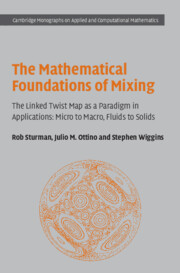 The Mathematical Foundations of Mixing
The Mathematical Foundations of Mixing Book contents
- Frontmatter
- Contents
- Preface
- Acknowledgments
- 1 Mixing: physical issues
- 2 Linked twist maps: definition, construction and the relevance to mixing
- 3 The ergodic hierarchy
- 4 Existence of a horseshoe for the linked twist map
- 5 Hyperbolicity
- 6 The ergodic partition for toral linked twist maps
- 7 Ergodicity and the Bernoulli property for toral linked twist maps
- 8 Linked twist maps on the plane
- 9 Further directions and open problems
- References
- Index
6 - The ergodic partition for toral linked twist maps
Published online by Cambridge University Press: 03 February 2010
- Frontmatter
- Contents
- Preface
- Acknowledgments
- 1 Mixing: physical issues
- 2 Linked twist maps: definition, construction and the relevance to mixing
- 3 The ergodic hierarchy
- 4 Existence of a horseshoe for the linked twist map
- 5 Hyperbolicity
- 6 The ergodic partition for toral linked twist maps
- 7 Ergodicity and the Bernoulli property for toral linked twist maps
- 8 Linked twist maps on the plane
- 9 Further directions and open problems
- References
- Index
Summary
This chapter discusses the application of Pesin theory to linked twist maps. Drawing on three key papers from the ergodic theory literature we give the proof that linked twist maps can be decomposed into at most a countable number of ergodic components.
Introduction
In Chapter 4 we gave Devaney's construction of a horseshoe for a linked twist map on the plane. The existence of the horseshoe and the accompanying subshift of finite type implies that the linked twist map contains a certain amount of complexity. However, topological features such as horseshoes may not be of interest from a statistical, observable, or measure-theoretic point of view, as they occur on invariant sets of measure zero. The subshift of finite type occurs on just such an invariant set of measure zero and is therefore arguably not of significant statistical interest. Nevertheless it is possible that similar behaviour is shared by points in the vicinity of the horseshoe, meaning that complex behaviour is present in a significant (that is, positive measure) domain. Easton (1978) conjectures that this may indeed be the case, and that in fact linked twist maps may be ergodic.
Three papers provide the framework for applying the results of Pesin (1977) connecting hyperbolicity and ergodicity. In this and the following two chapters we draw heavily on each of Burton & Easton (1980), Wojtkowski (1980) and Przytycki (1983).
- Type
- Chapter
- Information
- The Mathematical Foundations of MixingThe Linked Twist Map as a Paradigm in Applications: Micro to Macro, Fluids to Solids, pp. 159 - 193Publisher: Cambridge University PressPrint publication year: 2006


